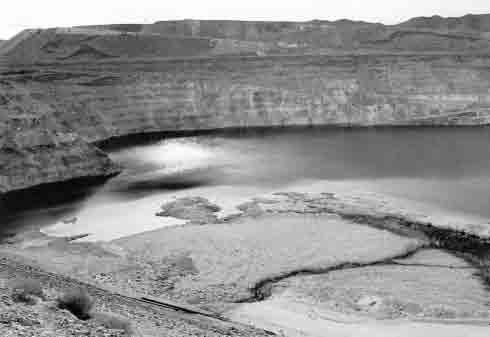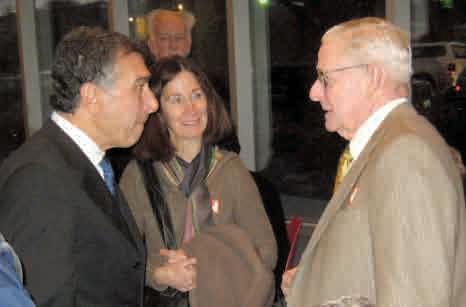
12 minute read
News
from Feb. 23, 2012
Tahoe agency held hostage?
A California Senate delegation has been named to negotiate with Nevadans about Tahoe issues, but the Golden State also provided an earful for Silver Staters.
Advertisement
The delegation of three California state senators and staffers was named in response to the enactment by Nevada of Senate Bill 271, which threatened Nevada withdrawal from the Tahoe Regional Planning Agency (TRPA) unless Nevada gets its way on some policy issues involving development at Lake Tahoe.
The bi-state TRPA was created after negotiations between California Gov. Ronald Reagan and Nevada Gov. Paul Laxalt in response to degradation of the Lake Tahoe basin, but TRPA failed to solve the problem. In 1980, voting reforms to made the agency more effective. Pro-growth advocates have chafed under TRPA’s activities ever since.
All anti-TRPA bills failed until last year when S.B. 271 was approved mostly by Southern Nevada legislators at the behest of the casino lobby. In a letter to Sen. John Lee of Nevada, who sponsored 271, California Sen. Darrell Steinberg appointed Sens. Alan Lowenthal, Fran Pavley and Ted Gaines to negotiate with Nevada. Steinberg, president pro tem of the California Senate, then wrote:
“In addition to responding to your request [for designation of negotiators], I want to share with you and your colleagues the displeasure many in California ... have with the recent unfortunate and rather provocative actions taken by the state of Nevada following years decades of cooperation over matters relating to our mutual interests in the environmental and economic sell being of the Tahoe basin. [Nevada’s S.B. 271] is both unnecessarily inflammatory and deeply counterproductive to the collegial relationship our two states have had on these matters. One can only imagine how leaders in Nevada would react if California were to take similar action. It is both surprising and disappointing to see a national treasure as important as Lake Tahoe become a political hostage to the agenda of special interest groups who have little interest in the many values the region provides. Despite the verbiage in the Nevada legislation, dissolution of the Tahoe Compact would require an Act of Congress and would have deeply disruptive effects on Lake Tahoe’s economy and environment.”
One former TRPA member attributes the success of S.B. 271 to casino lobbyist William “Billy” Vassiliadis. A surprising number of Democrats cast what are considered anti-environment votes on the issue. Not one Republican in either house of the legislature opposed 271. But nine Democrats in the 42-member Assembly voted for the bill, giving it a majority. They were Elliot Anderson, Kelvin Atkinson, Irene Bustamante, Marcus Conklin, Marilyn Dondero Loop, Jason Frierson, William Horne, Steven Horsford, Marilyn Kirkpatrick, Harvey Munford, Dina Neal, and John Oceguera. All are from Southern Nevada and Oceguera is speaker of the Assembly.
In the 21-member Senate another nine Democrats joined with Republicans. They were Shirley Breeden, Allison Copening, Ruben Kihuen, John Lee, Mark Manendo, David Parks, Michael Schneider and Valerie Weiner. Again, all are from Southern Nevada. Democrat Lee was the bill’s sponsor. Horsford is the Democratic floor leader in the Senate. The only Senate Democrats to oppose the bill were Sheila Leslie and Mo Denis.
Urban Nevada
The 2012 Republican caucuses may have helped correct views of Nevada. As we have reported several times in recent years, Nevada is one of the nation’s five most urban states. The state got so much depth coverage in advance of the caucuses that some national reporters expressed surprise that it is not the rural enclave they had assumed. Some Nevadans might also be surprised.
“But do not be fooled by the scenery,” wrote Micah Cohen in the New York Times. “Where elections are concerned, Nevada is an urbanized state. Most Nevadans live in cities, and that holds true for Republicans and for Republican caucusgoers.”
His piece was accompanied by a map that showed where the state’s Republicans live—82 percent of them in Clark and Washoe counties. Elko County, which often sets the tone for the state party, has just two percent of the state’s GOP voters.
The onion field
Critics say federal testing is less than meets the nose
“The scent of onions often perfumes the air,” wrote someone on an online messageby Dennis Myers board in response to someone who had asked for information on Yerington, where she had been offered a job. On the other hand, the minutes of a Lyon County Commissioners meeting in 2010 reported that during the public comment period a local resident “spoke about the odor and fly issue in south Mason Valley due to rotting onions.”
Paiute Yerington Tribe
On a third hand, Peri and Sons Farms, an operation with an ambitious organic program, has an interest in having its onions thought of positively: “Our onions are ethicallygrown using certified, clean, safe and traceable practices,” reads its website.
Now, those heavily debated onions, a mainstay of Lyon County, have become a player in new debates over an earlier mainstay of the county—the now-abandoned Anaconda mine pit.
For the better part of a century, regulation of Nevada mines was minimal, with the result that when a mine closed, the owners could more or less walk away. They didn’t have to replace their divots or clean up after themselves. As a result, there are nasty environmental hazards all over the state.
In Lyon County, Anaconda shut down its 3,400-plus acre copper mining operation near Yerington in 1982 after 64 years. It had opened during World War I as the Empire Nevada Mine. When operations ceased, so did groundwater pumping, with the result that the open pit filled, and a huge lake is now in the pit.
Atlantic Richfield (ARCO) acquired the Anaconda Copper Mining Company in 1977 for $700 million, a fateful purchase. Copper prices soon tumbled and Anaconda operations in Nevada and elsewhere were closed. What ARCO mostly got from the purchase was a lot of environmental disaster sites. Pit operations in Montana and Nevada are now on Superfund application lists, but the likelihood of the Nevada site getting much Superfund money anytime soon is unlikely because “it is not on the National Priority List (NPL) of sites,” according to the U.S. Environmental Protection Agency (EPA). Nevada has sought Superfund money for more than 200 sites, most of them former mines, and only one—the bed of the Carson River, contaminated by Comstock-era mining wastes—has been designated a Superfund site.
Part of that lack of urgency about Yerington stems from testing done by the EPA. Testing in 2004 suggested levels of uranium were higher than the EPAstandard (“Environment,” RN&R, April 15, 2004), but in 2007 it conducted additional tests.
Though there has been talk of reactivating the old Anaconda open pit mine in Lyon County, so far it has come to nothing.
AMarch 2011 EPAbulletin on the Lyon County site read in part, “In 2007, EPAconducted tests of onions grown adjacent to the Anaconda site and irrigated from a supply well located just north of the site boundary. The onions were selected from random areas of the field and were not washed or trimmed prior to analysis. The onions were analyzed for uranium, a primary site contaminant. The results showed that uranium levels in the onions were low, and below levels typically found naturally in onions from other areas of the United States. Accordingly, EPAconcluded that the test results showed that the Anaconda mine did not elevate uranium levels in local onions.”
EPAliked that verbiage so much that it repeated it word for word in a subsequent bulletin issued in August.
But last week Associated Press reporter Scott Sonner reported that newly available documents indicate that what the EPAcalled “tests of onions” was insufficiently specific. They were actually tests of four onions. That’s four individual onions, not four cartons of onions.
Sonner reports that the Colorado contractor who obtained the four onions warned the EPAthat they constituted an inadequate sample for final conclusions.
The APrevelation incensed some residents of the area, including the Yerington Paiute Tribe.
In November the tribe issued a prepared statement that called for “capping the site—a method that covers a mine site to substantially eliminate movement of contaminants from the site—[as] the only appropriate measure due to the threat from contaminated soil and water. The estimated cost of this option is $60,000,000 but would qualify for the federal Superfund program. … Capping this part of the Anaconda mine site not only helps address the threat to community health and natural resources but it also presents a substantial economic development opportunity for Lyon County through job creation associated with the project.”
The EPAhas gathered pledges for about $6 million from various past operators of the mine, including $2.7 million from short-term owner ARCO.
With Superfund money unlikely and EPAaction uncertain, that left the issue to the courts, and many residents are suing ARCO. U.S. District Judge Robert Jones last week set a trial date in June 2013, saying that it will take at least that long for discovery proceedings in such a monster case.
Some remediation, such as the removal of tons of contaminated soil, has been done at the site, but it remains an ecological disaster area.
Besides soil contamination, water is also an issue. EPAtests in 2010 found uranium and arsenic levels in most drinking water to be far above what the agency considers safe. For eight years BP, the corporate parent of ARCO, has provided bottled water to residents whose wells have heavy concentrations of uranium.
In April last year, Singatse Peak Services of Vancouver became the latest owner of the land. At the time, Singatse CEO Thomas Patton said he hoped to reopen the mine in view of rising copper prices and because “one of the quickest, most efficient methods of correcting issues at former mine sites is to put those sites back into production.” That has not happened.
Peri and Sons Farms, once described by a farming trade journal as “Crusaders for Onions Born in the U.S.A.,” has a stake in the purity of the soil, which would seemingly make Peri and the tribe natural allies. But Peri attorney Brad Johnson said he is satisfied with the EPA’s assessments, and he was harshly critical of the tribe for faulting the small onion sample.
“The EPAis not basing its statements and conclusions just on the [onions] sample,” he said. “The tribe ignored all the other evidence,” including additional agriculture studies.
Johnson claimed the tribe has made allegations that are “demonstrably false,” including that the test onions were already packed for distribution when obtained and that a Peri well is contaminated when in fact that well no longer actually exists.
He said further, “There is an effort by them to promote a litigation strategy for the benefit of the tribe.” Peri had offered to meet with the tribe without success, he said.
Johnson was also critical of the APfor not including more of a written statement he gave Sonner in its story.
Tribal environmental consultant Dietrick McGinnis said of Johnson’s statements, “We’ve met with them before. Their reaction is a bit of a surprise.”
He said there are more than 40 substances that are suspect besides uranium and he is not satisfied with the EPAwork. “There’s many issues associated with that site,” he said. “Uranium is just one of them.”
In a letter to the tribe last week, the EPA’s San Francisco office said the agency “considered many lines of evidence” in making its determination of safety in farm products. Ω
Brad Johnson Peri and Sons Farms lawyer
Mazel tov!

John Farahi (left) and Debbie Pomeranz greeted John Marshall enthusiastically at a gathering at the Nevada Museum of Art. Marshall wrote the book Jews in Nevada, which became the basis for a public broadcasting program of the same name that debuted this month on stations in Reno and Las Vegas.
G. LOVE & SPECIAL SAUCE
SATURDAY, FEBRUARY 25
GEORGE THOROGOOD AND THE DESTROYERS
SATURDAY, MARCH 3
PAUL REVERE AND THE RAIDERS
SATURDAY, MARCH 10
DRIVE-BY TRUCKERS
SATURDAY, MARCH 17
ROCK SUGAR
SATURDAY, MARCH 24
BLUE ÖYSTER CULT
SATURDAY, MARCH 31
Tickets available at the Box Office, by calling 1-800-786-8208 or online at SouthShoreRoom.com.
See box office for details and age restrictions. Shows subject to change or cancellation. Must be 21 or older to gamble. Know When To Stop Before You Start.® Gambling Problem? Call 1-800-522-4700. ©2012, Caesars License Company, LLC. RNR-022312




Piped up
The Keystone XL pipeline is starting to seem like a never ending story, and it may not be one with a happy ending. Despite dozens of activist organizations including OccupyKXL and the National Resources Defense Council rallying in opposition, plans to once again move forward with the pipeline—which will transport oil from Alberta, Canada, to the southeastern coast of Texas—were approved with a 237-187 vote in the House of Representatives on Feb. 16. TransCanada, the Canadian company behind the project, announced that the pipeline would be operable by 2015. Business Insider reported that the project is estimated to cost $7 billion.
The bill passed as part of a larger one that lumps together two other issues: earmarks for oil companies to drill in the Arctic Wildlife Refuge and the go-ahead to open up the coasts of Florida for off-shore drilling.
But those who oppose the pipeline aren’t going down without a fight. A judge in Lamar County, Texas, issued a restraining order to prevent construction of the pipe on a farm near Paris. However, the company has previously taken other farmland by eminent domain.
At a climate change summit in Washington on Feb. 17, Canadian environmental minister Peter Kent encouraged support for the pipeline. At the same summit, he also announced a new plan, in partnership with U.S. Secretary Of State Hillary Clinton, to reduce carbon emissions.
Sunny days ahead
Two more local schools have implemented renewable energy resources to help power facilities. Last month, Reed High School and North Valleys High School installed 1.5-megawatt solar power systems. According to the Washoe County School District, the project was funded entirely by rebates from NV Energy, and the solar panels are estimated to save the district $270,000 annually from energy costs.
A press release from the district states, “The savings will be realized within the operating general fund and purposed for classroom essentials, educator salaries, and student textbooks and materials.”
Carson High School added solar panels last October, and two schools in Lander County recently installed wind turbines (“Cool schools,” Feb. 2).
—Ashley Hennefer
ashleyh@newsreview.com
ECO-EVENT
Hungry Mother Farm and Full Circle Compost will host the third annual seed swap on March 3. Bring your own seeds to swap or get rare, locally grown heirloom varieties. Seeds are available for flowers, vegetables, trees, shrubs and more. If you do not have seeds to swap, a small donation is requested. Workshops and demonstrations will also be available on soil fertility, raised bed gardening, seed germination, vegetable gardening and healthy lawns. 10 a.m.-3 p.m. Full Circle Compost and Hungry Mother Farm Stand, 3190 Hwy 395, Minden. www.hungrymother.cc.
Got an eco-event? Contact ashleyh@newsreview.com. Find more at facebook.com/rnrgreen.






